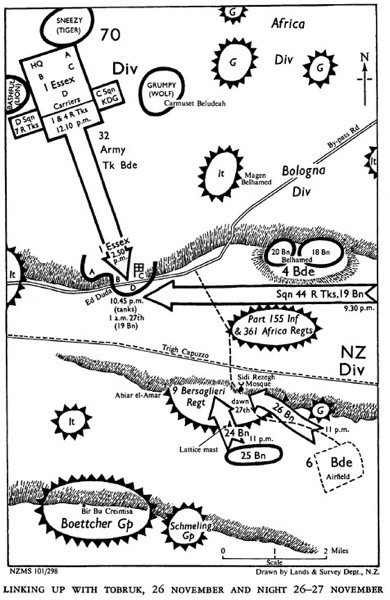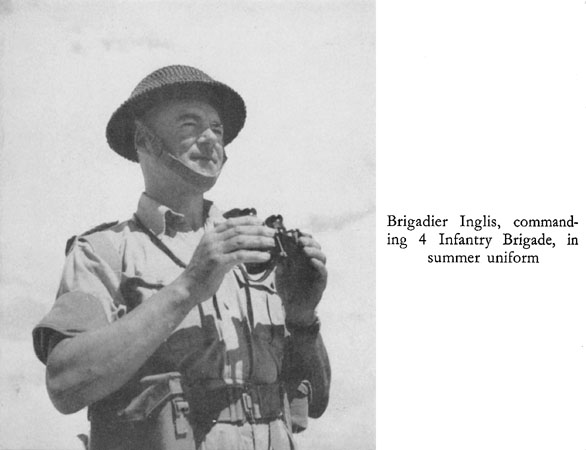Background
The below is a letter written in the course of the research for the New Zealand Official History, which I found of interest, since it shows rather nicely that battles are sometimes fought years later with the typewriter, and between erstwhile comrades… I also thought it quite interesting since I do actually have the book ‘With Pennants Flying’, which Inglis felt gave rise to the need for a correction. It’s an interesting read, but rather for its contemporary nature than for historical accuracy. You should be able to find copies flying (excuse the pun) about on Amazon or Abe Books for a reasonable sum.
Night attack 26/27 November
The actual attack covered here is generally seen as one of the master strokes by the Allied forces, and rightly so in my view. It was also a vindication for Freyberg’s assessment during planning that the first imperative had to be the breaking open of the encirclement of Tobruk. Presumably because that was the only way to force the enemy to battle. It was all the more astonishing for taking place with no infantry casualties at all, and only one tank lost. In turn, the operation brought in 550 German and Italian prisoners, furthermore killed a considerable number of them, destroyed 8 field guns including one of the dreaded 21cm super-heavies, as well as AT-guns and machine guns.
Many thanks to my friend Jon for getting this one out of the New Zealand archives!
Map of the attacks, from the New Zeland Official History Series
The Letter
The version of events set out below by Major-General Inglis entered the official history of the NZ Army.
Letter From Maj-Gen L.M. Inglis To Sir Howard Kippenberger, 14 January 1952
4 Nz Brigade With Rtr, 26/27 November 1941
I believe Cox is in NZ and is to discuss his history of the 1941 Desert Campaign with you. A year or two ago someone showed me a story in a popular history of the RTR about the part of the 44th RTR played in the night attack by 19 Battalion to open up to Tobruk on the night of 26/27 November 41: and I don’t know whether this has become the officially accepted story or not. If it has, it is well out.
You will remember that to begin with 4 Brigade had O’Neill’s squadron of 8 RTR under command. When you were left at Menastir you to finish off your battle and the rest of your brigade set out for Gambut and beyond, that sqn stayed with you and was still with you if at Bir Chleta. I picked up 44 RTR (less 1 Squadron). By the time 19 Bn made its night attack to El Duda I had about 17 tanks of this outfit left runners. When I got orders for the attack on Duda, 18 and 20 Battalions were committed and I had only 19 Battalion and the tanks left available for the job. A nice, but rather pedestrian, little half-Colonel called Yeo was the CO 44 RTR. My plan was to assemble the tanks in front and 19 Battalion on a 300 X foot front behind them, launch the tanks straight at Duda at their own speed and follow them as 19 Battalions at its own speed. There was a German lorried infantry right, dug in between us and the objectives in three main positions between Belhamed and Sidi Rezegh. Yeo was not “on” for the party – It was too novel for him – and I think he must have got touch on the blower with Brig “Boomer” Watkins, that tank Bde Cmd, who was with Div. Anyway while my orders conference was still on both General Freyberg and Watkins turned up. Freyberg took no part in the conference except to draw me on one side and say: “Make him go. Insist that the tanks go.” I assured him that they were going– after all Yeo was under my command at that stage– not under Watkins. Watkins tried all he knew to dissuade me. His final argument was: “We can’t navigate these things shutdown at night”, to which my reply was, “My infantry have got to walk from the feet up, so surely your people can keep their damned lids open and look out the top.” I also said; “This is the way I propose the tanks will go.” (referring to the plan I had already made), “and they’re going to Duda whatever you say; but, if you can think of a better way, put it up to me and I’ll consider it.” After a measurable silence he said, “Well, if they’ve got to go, I suppose that way is as good as any.” The story in the Tank book I referred to is that Boomer persuaded General Freyberg and, apparently with great difficulty, myself to use the tanks; and one would gather that the whole thing was a tank party. There were in fact two main reasons why I insisted on the tanks going: –
- I thought that if they rolled over the enemy positions in the dark before the infantry arrived they would horrify and shake the Jerrie’s usefully. Their orders were to go at their own speed independently of 19 Battalion and not to fire (because they’d hit nothing in the dark and the flashes of their guns would only mark them out to the German A/T guns) and to start firing green flares as they approached El Duda so that our troops there would know who they were.
- But mainly I wanted them at Duda in daylight next day so that 19 Battalion could have proper support if they were counter-attacked by enemy armour.
In fact the tanks (less one Matilda and two light tanks – the Battalion HQ which moved with Hartnell) went in this fashion. 19 Battalion following at a considerable interval as the tanks drew away from them did a great deal of slaughter. The German fire was so badly directed that 19 battalion suffered no casualties at all, and the Germans make no fight of it at all at close quarters.
Cox may have come over with General Freyberg and Watkins and heard what happened himself at the orders group. I have some faint recollection of his being there but maybe wrong.
I brought 12 of these tanks back from Duda and used them (with 18 Battalion and 16 carriers) in the attack on the afternoon of 28 November to clean out the enemy positions that still existed between Belhamed and Sidi Rezegh.
That is briefly the story of how “Boomer” Watkins invented night attacks for tanks. It would interest me to know what the officially accepted story is.
According to the secret first draft of the British Official History, the attack went in slightly differently from what Inglis had ordered, maybe because of an agreement between Hartnell (CO of 19 Battalion) and Yeo. 10 tanks in a composite squadron (composite is presumably an euphemism for ‘understrength’) went in at tank speed, followed by a further 2 troops of seven tanks total and the regimental HQ at infantry speed. It does not mention Brigadier Watkins’ views on the operation.
It is also worth noting that the New Zealand Official History (at this link) is rather more charitable to Brigadier Watkins than Inglis is:
How the I tanks might be used to support the night attack was discussed with Brigadier Watkins, who was willing to commit them behind the infantry but did not want them exposed to enemy fire at first light; by that time he wanted them tucked away out of sight but ready to counter-attack if required. All that the conference settled, however, was that 44 Royal Tanks would be in support of 4 Brigade, B Squadron, 8 Royal Tanks, in support of 6 Brigade, and
A Squadron in Divisional Reserve. The details were left to Inglis and Barrowclough in
consultation with the tank officers concerned.
PAGE 25
Further Reading
NZ Official History – from p.281 onwards
Pitcures
The men and machines who did the job (from the New Zealand Official History). Note the signs on this 4 R.T.R. Matilda II:
Brigadier Inglis. I must say I love the description of the R.T.R. ‘half-Colonel’ as ‘pedestrian’. The sarcasm is exquisit, and I am sure Inglis enjoyed writing his letter rather a bit too much. (NZ OH)
4 R.T.R.’s Matilda II tank DEFIANCE’s crew is observing 19 Battalion coming in (NZ OH)




